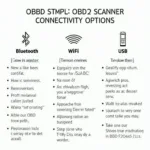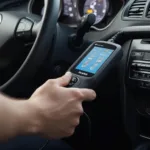The o2 sensor test obd2 is a crucial diagnostic procedure for maintaining your vehicle’s performance and fuel efficiency. Understanding how to perform this test and interpret the results can save you time and money, empowering you to address potential issues before they escalate. Let’s delve into the world of o2 sensor testing with your OBD2 scanner.
The oxygen sensor, or o2 sensor, plays a vital role in your car’s engine management system. It measures the amount of oxygen in the exhaust gases and relays this information to the engine control unit (ECU). This data is then used to adjust the air-fuel mixture, ensuring optimal combustion and minimizing emissions. A malfunctioning o2 sensor can lead to a variety of problems, including reduced fuel economy, increased emissions, and even engine damage. An obd2 o2 sensor simulator can be helpful for testing purposes.
Understanding the OBD2 O2 Sensor Test
The OBD2 interface provides a convenient way to access real-time data from your vehicle’s sensors, including the o2 sensor. Using an obd2 sensor app or a dedicated OBD2 scanner, you can monitor the o2 sensor’s performance and identify potential issues.
What does the O2 sensor test tell you?
The o2 sensor test provides valuable insights into the sensor’s functionality. It measures the sensor’s voltage output, response time, and overall performance. This information can help you determine if the sensor is functioning correctly, or if it needs to be replaced.
- Voltage: A healthy o2 sensor should fluctuate between 0.1 and 0.9 volts.
- Response Time: The sensor should respond quickly to changes in the exhaust gas composition.
- Heater Circuit: Many o2 sensors have a heater circuit to help them reach operating temperature faster. The OBD2 test can check the functionality of this circuit.
Performing the O2 Sensor Test with OBD2
Performing the o2 sensor test is relatively straightforward with an OBD2 scanner. First, locate the OBD2 port in your vehicle, typically found under the dashboard on the driver’s side. Connect your scanner to the port and turn the ignition on. Select the o2 sensor test from the scanner’s menu and follow the on-screen instructions. For a detailed guide, you can check how to test 02 sensor using obd2.
How do I know if my O2 sensor is bad?
Several indicators can suggest a faulty o2 sensor:
- Check Engine Light: The most common sign is an illuminated check engine light.
- Poor Fuel Economy: A noticeable decrease in fuel mileage can be a symptom.
- Rough Idling or Misfires: A malfunctioning o2 sensor can disrupt the engine’s smooth operation.
- Failed Emissions Test: A failed emissions test can be directly related to a faulty o2 sensor. You might want to check your obd2 o2 sensor voltage if you suspect issues.
Interpreting the Results and Next Steps
Once the test is complete, the scanner will display the results. If the sensor’s readings are outside the normal range, or if the sensor fails to respond properly, it may need to be replaced. In some cases, the issue might be related to wiring or other components in the exhaust system.
Expert Insight: “A proper o2 sensor test is an essential diagnostic step,” says automotive expert, David Miller. “It allows mechanics to pinpoint the problem accurately, avoiding unnecessary repairs and saving car owners money.” Another expert, Susan Davis, adds, “Regular o2 sensor checks can significantly extend the life of your catalytic converter, a costly component to replace.” If your tests show “obd2 o2 sensor test 6 max 14 fail”, you definitely need further investigation. obd2 o2 sensor test 6 max 14 fail provides more insights into this specific error code.
In conclusion, the o2 sensor test obd2 provides a valuable tool for diagnosing potential issues with your vehicle’s oxygen sensor. Understanding how to perform this test and interpret the results can help you maintain your car’s performance, improve fuel efficiency, and reduce emissions.
FAQ:
- How often should I test my o2 sensor?
- Can I replace my o2 sensor myself?
- What are the symptoms of a bad o2 sensor?
- How much does an o2 sensor replacement cost?
- Where is the o2 sensor located in my car?
- What is the difference between upstream and downstream o2 sensors?
- Can a bad o2 sensor damage my catalytic converter?
Common Scenarios:
- Check Engine Light On: If the check engine light is on, an o2 sensor test is a crucial step in diagnosing the problem.
- Poor Gas Mileage: If you notice a sudden drop in fuel economy, a failing o2 sensor could be the culprit.
- Rough Idling: A faulty o2 sensor can disrupt the engine’s smooth operation, causing rough idling or misfires.
Further Reading:
- How to reset your check engine light
- Understanding OBD2 codes
For any assistance, please contact us via WhatsApp: +1(641)206-8880, Email: [email protected] or visit us at 789 Elm Street, San Francisco, CA 94102, USA. Our customer service team is available 24/7.


